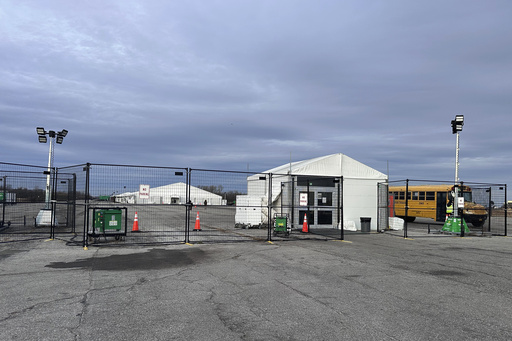NEW YORK – New York City is set to downsize its extensive emergency shelter system established for a substantial influx of migrants, as the number of new arrivals continues to decline. In light of President-elect Donald Trump’s pledge to implement mass deportations upon his return to office next month, changes are being made at a rapid pace.
Mayor Eric Adams announced on Tuesday that a substantial tent shelter accommodating over 1,800 migrants, situated at a former airport in Brooklyn, will be shutting down on January 15, with plans to relocate residents to alternative facilities. This facility is among 25 sites that have recently been closed or are slated for closure, including another sizable tent complex on an island park near Manhattan, which is expected to cease operations in February.
Following the November elections, concerns have heightened among migrants and their advocates regarding the potential risks associated with remaining at the Floyd Bennett Field shelter. Given its location on federal land, there are fears that families housed there could become prime targets for Trump’s deportation agenda. Mariama Barry, a 26-year-old mother from Guinea who has been residing at the airfield for the past year, expressed her fears about the implications of Trump taking office. She highlighted her dire situation, having fled her home country to escape a forced marriage and to protect her daughter from genital mutilation.
“I thought we were going to be safe here,” Barry stated outside the shelter’s gate last week, voicing her anxiety regarding the potential deportation and facing the very dangers she sought to escape. Advocates have welcomed the announcement of the shelter’s closure but emphasized that they will monitor subsequent actions closely to ensure the safety of migrants from any potential federal immigration enforcement and to minimize disruptions to essential services like schooling, healthcare, and employment.
The Legal Aid Society and Coalition for the Homeless criticized the appropriateness of the facilities, stating, “Floyd Bennett Field – a semi-congregate facility where families with children live in tents on an unused airfield mired in a flood zone, miles from schools, and other services – was always the wrong location to shelter vulnerable families with young children.”
The impending closures of Floyd Bennett Field and similar shelters mark a significant shift in the Democratic administration’s approach to managing the roughly 250,000 migrants that have come to New York City since the spring of last year. In November alone, 11 additional shelters closing down provided about 1,800 beds, including ones located in isolated areas like John F. Kennedy Airport and an old college dormitory on the Upper East Side of Manhattan.
The administration’s efforts to shut down all ten shelters operated in five upstate counties are also set to be completed by the end of the month. Although Mayor Adams has refrained from providing details concerning Floyd Bennett Field in recent weeks, his announcement did not mention any direct concerns tied to the incoming Trump administration, which officially resumes power on January 20. The last migrants are anticipated to vacate the airfield five days earlier, with its historical significance as the city’s first airport and a former naval station.
Adams attributed the closures to his administration’s management strategies, including the implementation of new immigration policies that limit how long migrants can be in city care. “Thanks to our smart management strategies, we’ve turned the corner,” he mentioned, asserting that these shelter closures demonstrate the city’s superior handling of the migrant crisis compared to others nationwide. He also noted ongoing efforts to consolidate shelters to streamline operations and save taxpayer funds.
Trump’s transition team did not immediately reply to requests for comments but had previously indicated intentions to launch extensive deportation operations targeting illegal immigrants involved in crime. In recent months, New York City has experienced a consistent decline in new migrant arrivals, a trend that mirrors patterns seen in other large cities across the United States.
Currently, the city shelters about 55,000 migrants across roughly 200 temporary locations, a significant drop from nearly 70,000 at the beginning of the year. As of early December, over 500 newcomers entered the city’s shelter system, a stark decrease compared to the peak of around 3,450 recorded in early January.
Similar trends of decreasing migrant shelter operations have been observed in other major cities, attributed to the new asylum restrictions introduced by President Joe Biden in June. Denver recently closed its last temporary housing facilities after accommodating up to 5,000 migrants, while Chicago currently supports approximately 2,700 individuals across seven sites, down from 15,000 residing in 28 shelters the previous December.



